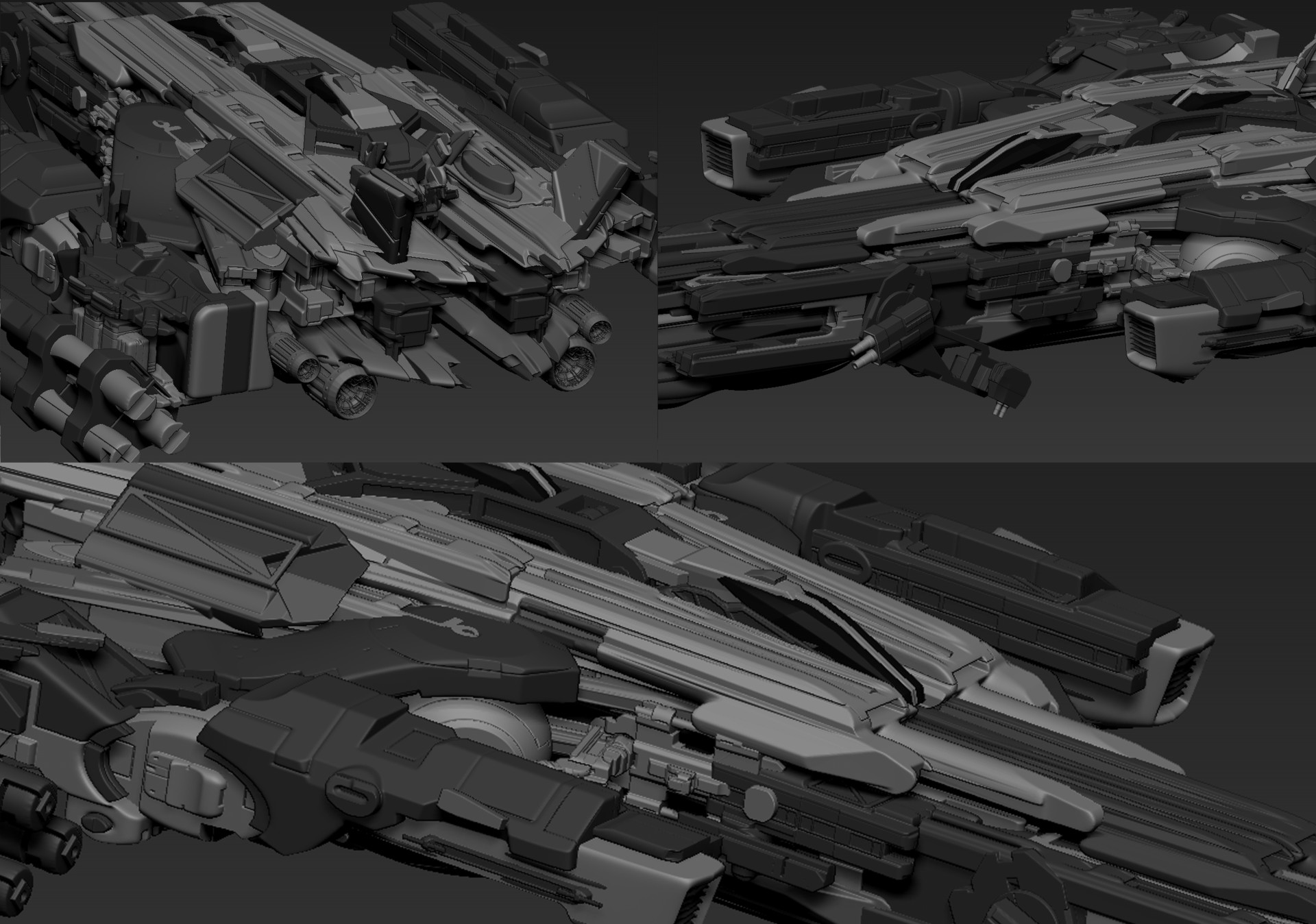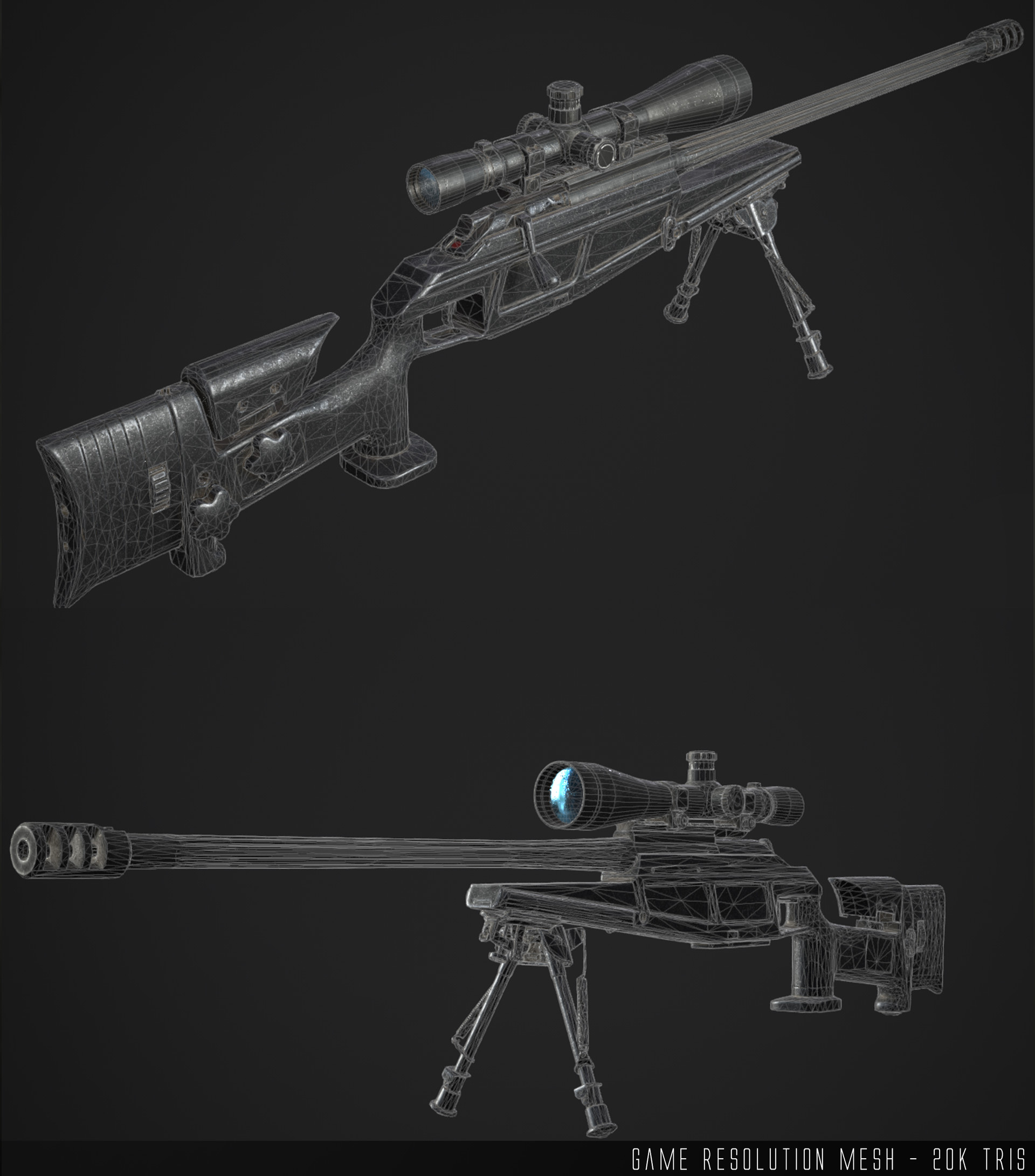Should I not showcase decimated objects in my portfolio?
Hey guys,
So I was just wondering is it considered unprofessional/lazy to have game assets decimated rather than retopologized by hand? And I am not talking about characters, or things that will be deforming. I am talking more about things like rocks to weapons and even bigger assets like spaceships. Should I avoid showing decimated objects in my portfolio?
For example here is a sculpt that I've done of a spaceship, which would take me days to properly retopologize:

Or even this weapon:


Does the above seem like a reasonable topology or should I be doing this all by hand?
As far as I understand, when you are actually working in studio setting already, it's okay to be decimating objects as I was talking with Michael Pavlovich about this who did these awesome Houdini tutorials https://www.youtube.com/watch?v=AxpImb2tGII&list=PLkzopwqcFevZLnQIIU8GTGwg4o7RaarZU
https://www.youtube.com/watch?v=AxpImb2tGII&list=PLkzopwqcFevZLnQIIU8GTGwg4o7RaarZU
He said that you can either choose optimize the mesh another 5% by doing everything by hand and spending another week on it, or doing it all in a day and losing a tiny bit of the quality. The question here is, are the people that are checking your portfolio more interested that you can do everything by hand, or that you can do everything as fast as possible whilst sacrificing some amount of the quality?
I am planning on creating a tutorial myself about making a game asset from start to finish, so I was wondering if it would be wrong to show people that you can decimate objects instead of doing it by hand? On one hand you want to show the people most optimal/fastest way of creating an optimized game asset, but at the same time you want to know that it's up to the standard.
And then the same goes for automatic uvs. I feel like it would not be an issue to use automatic UVs for things like rocks, but not sure about things like weapons and bigger assets.
Would be interesting to know what you think about this topic. I know this is a long-winded question, but it's been on my mind for quite some time.
So I was just wondering is it considered unprofessional/lazy to have game assets decimated rather than retopologized by hand? And I am not talking about characters, or things that will be deforming. I am talking more about things like rocks to weapons and even bigger assets like spaceships. Should I avoid showing decimated objects in my portfolio?
For example here is a sculpt that I've done of a spaceship, which would take me days to properly retopologize:

Or even this weapon:


Does the above seem like a reasonable topology or should I be doing this all by hand?
As far as I understand, when you are actually working in studio setting already, it's okay to be decimating objects as I was talking with Michael Pavlovich about this who did these awesome Houdini tutorials
 https://www.youtube.com/watch?v=AxpImb2tGII&list=PLkzopwqcFevZLnQIIU8GTGwg4o7RaarZU
https://www.youtube.com/watch?v=AxpImb2tGII&list=PLkzopwqcFevZLnQIIU8GTGwg4o7RaarZUHe said that you can either choose optimize the mesh another 5% by doing everything by hand and spending another week on it, or doing it all in a day and losing a tiny bit of the quality. The question here is, are the people that are checking your portfolio more interested that you can do everything by hand, or that you can do everything as fast as possible whilst sacrificing some amount of the quality?
I am planning on creating a tutorial myself about making a game asset from start to finish, so I was wondering if it would be wrong to show people that you can decimate objects instead of doing it by hand? On one hand you want to show the people most optimal/fastest way of creating an optimized game asset, but at the same time you want to know that it's up to the standard.
And then the same goes for automatic uvs. I feel like it would not be an issue to use automatic UVs for things like rocks, but not sure about things like weapons and bigger assets.
Would be interesting to know what you think about this topic. I know this is a long-winded question, but it's been on my mind for quite some time.

Replies
First of all i loved that video you posted, it's the first time i see a video related to houdini and i can say it's rather handy that you can do all these stuff in 1 program. I might consider this for the future.
Secondly, i do not believe you should show your lazy side on the portfolio, taking the time to do these by hand will show your effort, commitment, hard work and quality as an artist. Trading quality for quantity will be the decision of your lead artists/supervisors. Everybody can learn to click 2 buttons and roll 2 sliders and achieve a "somewhat" desired result. But making a mobile game or VR for example, has a lot of limitations at the present day, which means there should be maximum quality with the minimal density possible, and that needs human touch.
In the video you showed, an automatic uv created so many islands, which further increases the vertex number by a lot in such a prop. Smoothing groups also create extra vertices (at least in ue4 that i work with) so there goes more quality. You do this for 1 prop it's okay, but a whole scene could easily take up alot of extra space doing stuff like that.
Having said the above, the rifle you provide with a wireframe seems to me that can be reduced further in triangles but that always depends on the project you are working with. Most modern games don't really have a problem with vertices (unless for mobile or VR from what i've noticed) so propably you can get away with it. Nonetheless you should show dedication in your portfolio pieces, OR you could provide with both wireframes, the 5 minute version and the 1 afternoon version. You cannot go wrong with that
You need to be practiced in retopology because it matters for baking, rigging, animation... this is all important stuff for game models. Static environment props you could probably auto-unwrap, but weapons and vehicles? I think it would be good to be very efficient in manually retopoing these kinds of assets.
I want to argue, with items like the space ship, I can trust that you know how to retopo properly. It's sort of this feeling "really, how hard would it be to poperly retopo something THIS complex if you had the time?" I feel safe making the assumption with your work, AND if you had other game art examples, you'd know what to do.
He said that you can either choose optimize the mesh another 5% by doing everything by hand and spending another week on it, or doing it all in a day and losing a tiny bit of the quality.
it's also about reusable assets. imagine giving this triangle soup to a colleague for creating a variation. you'd have to watch your back at all times on the staircase - for the rest of the year...
game art isn't about spending the day doodling in zbrush.
For example; you start every model with a blockout model that becomes the basis for a low poly model afterwards.
The decimated gun just seems like it’s still too hi poly to me. You’re not showing how you can bake a model properly by just having all the detail modeled in.
I personally prefer to use zremesher for most models if I need a quick and dirty low poly.
to expand on this, one of the things that your portfolio showcases is your mentality and mindset. Showcasing a bunch of messy models because you wanted to save time isn't a great idea. I am a HUGE advocate of time management and working smarter not harder but this is a great example of shooting yourself in the foot. To me it showcases cutting corners, which can be ok if done smartly, but in this case its more likely to cause problems. It shows a lack of awareness of asset production in an intended team environment.
decimated models like that are a pain in the ass for other artists to work with, especially if they have to make 3-4 more levels of LOD's for world objects for most console games, trying to quickly LOD those models would be a huge time sink and nightmare.
It just looks kinda sloppy, and your portfolio should always be putting your best foot forward. You can try and justify it all you want, how it saves time etc but in the end it just looks rushed. This isnt anything against your work, the final results look great, its more about how practical this would be in an actual production environment.
I would much rather see someone showcasing how they re-used a big kitbash library to build a complex scene or mech/gun/vehicle asset and thats how they saved their time vs cutting corners that would self sabotage the asset at some point in production. Working smarter is great, and knowing where to save time is also important. Skipping re-topo because you hate it or it takes time isn't where you should be saving time and cutting.
looking at your art station there is no question you know what you are doing, your work is super solid. But something like this throws a wrench in the works when trying to see how the artist would fit in working with a team, unless this was a very specific workflow the studio was using, which in most cases, clean meshes are desired. The meshes we got back from outsourcing studios on WD2 were clean AF and super easy to work with..........hence why that vendor is still being used.